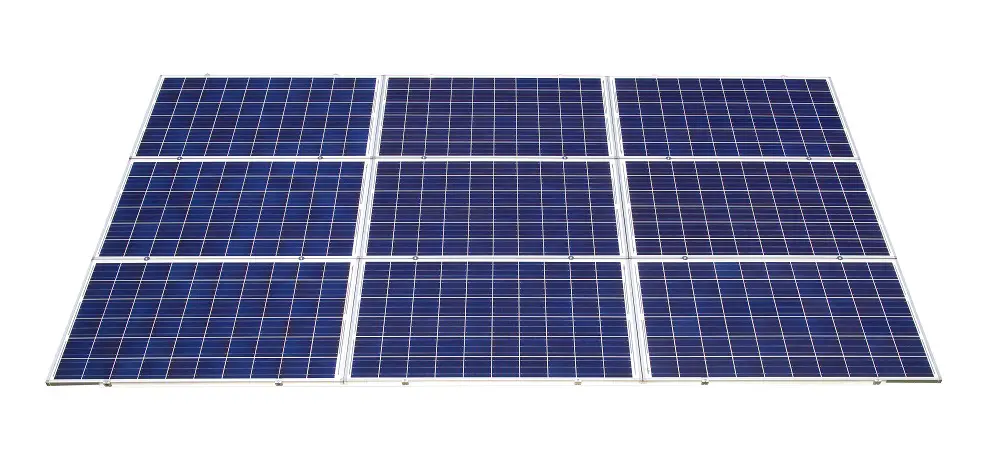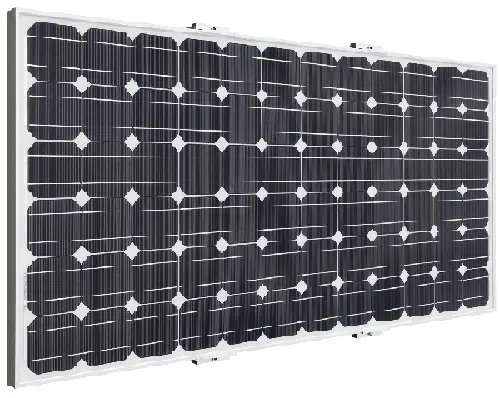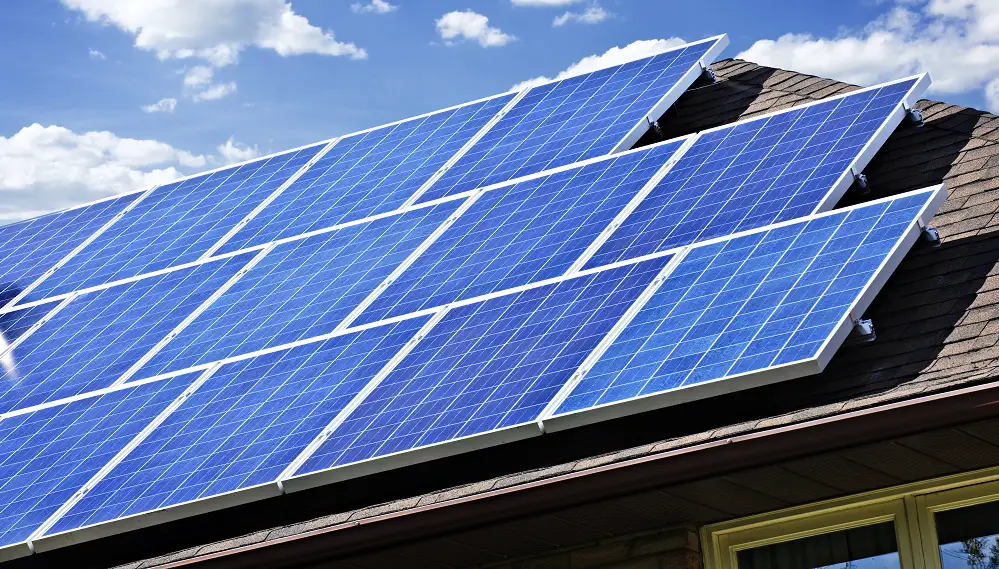Modern solar panels are made with silicon, which is a non-metallic element found in most electronics. Silicon is used because it's capable of absorbing most wavelengths of light in order to produce an electrical charge and because manufacturing costs to produce a near-perfect crystal are low.
The primary difference between polycrystalline and monocrystalline solar panels has to do with the purity of the silicon used in the module and the resulting orientation of the silicon crystals.
Let's explore other ways in which Polycrystalline and Monocrystalline solar panels differ:
Polycrystalline Solar Panels

Polycrystalline solar panels are composed of multiple silicon fragments creating what's known as a wafer. To do this, the material is methodically melted until it's molded together.
Due to this development process, the solar panels are called polycrystalline from the word "poly," which means several or multiples. When crafting these panels, the manufacturers emphasize cost-efficiency. This includes making sure the materials are effectively melted to reduce the space in which the electrons can move. By doing this, the solar panels work well while seeing a reduction in overall efficiency.
To distinguish between polycrystalline and monocrystalline panels, it's recommended to look at the underlying hue. Polycrystalline solar panels have a noticeable blue hue. In comparison, the monocrystalline solar panels come in a blacker hue.
Monocrystalline Solar Panels

Monocrystalline solar panels are marketed as being a superior, premium-grade technology by solar panel manufacturers. These solar panels are designed using silicon wafers, which are established using silicon bars before being manufactured into thinner "wafers."
With these solar panels, the emphasis is on using single-crystal silicon. This is why the solar panels are called monocrystalline since "mono" refers to a singular concept or material.
Monocrystalline panels are noted for being refined, aesthetically pleasing, and maintaining higher efficiency ratings across industry testing.
To earn its increase in efficiency, the single-crystal silicon offers electrons additional space to maximize electricity flow. With more space, the solar panels can do more with less effort and time compared to the average polycrystalline solar panel.
Polycrystalline vs Monocrystalline Solar Panels
While there are aesthetic differences to both panels along with underlying efficiency ratings, there's more to differentiate between the two popular options:
1. Cost
Investing in a solar power system involves establishing a budget and both solar panels offer unique price points in comparison to each other.
With monocrystalline solar panels, each wafer is far more expensive compared to polycrystalline solar panels. This can differ by significant amounts depending on the solar panel manufacturer especially with large-scale systems.
2. Output
Monocrystalline solar panels offer an increase in efficiency when it comes to power output and electricity flow. This has to do with the refined single-crystal silicon as it processes solar power. When the electricity flows through the cells, it doesn't meet increased resistance ensuring the process goes ahead smoothly.
In comparison, polycrystalline solar panels include multiple fragments that are melted together. This leaves inefficiencies within the setup causing interruptions in how the electricity flows.
Studies on this subject have shown the difference to be approximately 15% in total power output. This can be a noticeable factor in large-scale systems where the usage rate is high. To compensate for this discrepancy, polycrystalline solar panels come in at a reduced price.
The disparity in efficiency is placed down to silicon purity.
3. Longevity
The lifespan of a solar panel can play an essential role in determining the system's efficiency and financial viability. More than the installation costs, it's the lifespan of a PV system that matters and it begins with the core components such as the solar panels.
With the average PV system - a set warranty can be approximately 20-25 years depending on the solar panel manufacturer.
For polycrystalline solar panels, the warranty is sometimes reduced due to its weaker build quality. In comparison, monocrystalline solar panels are set as a premium-grade component and will often see warranties ranging between 25-30 years.
4. Temperature
Output metrics can vary depending on the conditions in a specific environment. In warmer conditions, monocrystalline solar panels are noted for providing increased efficiency ratings due to the panels preserving electricity flow with the rising temperature. In comparison, polycrystalline solar panels start to see a noticeable degradation in solar power output as the temperature increases.
Tropical climates can often single out this factor and begin to demonstrate why polycrystalline solar panels are less efficient across the board. As the temperature rises, the polycrystalline solar panels quickly begin to show signs of reduced output, which impacts the PV system.
In tropical conditions where the summers are longer and warmer, it's recommended to use monocrystalline solar panels.
5. Appearance
Since solar panels are visible (depending on the setup) it's essential to compare the appearances between the two solar panels.
As mentioned above, polycrystalline solar panels take on a blue hue. This blue color is due to the type of silicon (polycrystalline) that's used. The blue color is due to anti-reflective coating that's used to improve the absorption qualities of the panels.
In comparison, monocrystalline solar panels have a blackish hue. The black surface of the monocrystalline panel makes them more efficient at absorbing light.
Should You Use Monocrystalline or Polycrystalline?
Your choice depends on the following factors:
Spacing

A PV system is solely dependent upon the correct installation of the solar panels and how they're integrated into the property's layout. This includes making sure the solar panels are installed to maximize power output and electricity generation.
Due to this factor, a limited rooftop requires efficient solar panels to gain more value per square foot. This is where monocrystalline solar panels offer the most value and performance despite their cost.
For those with extensive space on top of the roof for a larger PV system, polycrystalline solar panels can be a cost-efficient option while generating significant power. With ground-mounted PV systems, it's possible to go with polycrystalline solar panels due to the added space.
Weather
Environmental conditions go beyond the amount of sun accessible to the solar panels daily. The weather plays an integral role in how efficient the solar panels are in generating electricity and maintaining reasonable efficiency metrics.
This includes factors such as snow, dust, and/or shade.
Polycrystalline solar panels are not only cost-efficient but also more durable in harsh weather conditions.
With monocrystalline solar panels in these conditions, it's possible to install them using what's known as a micro-inverter. This investment can yield good results and help maintain the desired efficiency metrics expected from a more premium-grade component.
Climate
Along with environmental conditions such as the weather, it's also important to focus on the climate (i.e. heat).
Monocrystalline solar panels can withstand hotter conditions such as tropical weather without breaking down and/or seeing a reduction in efficiency. On the other hand, polycrystalline solar panels are prone to seeing a drop in electricity flow as soon as the heat increases. Due to the added stress on the polycrystalline solar panels, this can age them prematurely.
This is not a major factor as both solar panels are resilient, it's still a variable that plays a role in the decision-making process when investing in a new PV system.
Final Thoughts
Polycrystalline and monocrystalline solar panels continue to be the gold standard for new PV systems. Industry experts continue to pour through the minor intricacies of what these panels yield, how they work, and their value in different conditions.
In general, the core emphasis is on efficiency as that is what drives an industry-grade PV system once it's been installed on-site. Based on underlying metrics, monocrystalline solar panels can provide a noticeable uptick in the efficiency of approximately 2-3%.
Keeping this 2-3% efficiency metric in mind, a large-scale operation can see a significant drop in performance across an entire year due to this inefficiency. On the other hand, a residential PV system can get away with polycrystalline solar panels.
Both solar panels last for a long time, offer great value, and integrate well with new-age properties. It comes down to appearance, 2-3% in efficiency, and durability based on environmental conditions.

